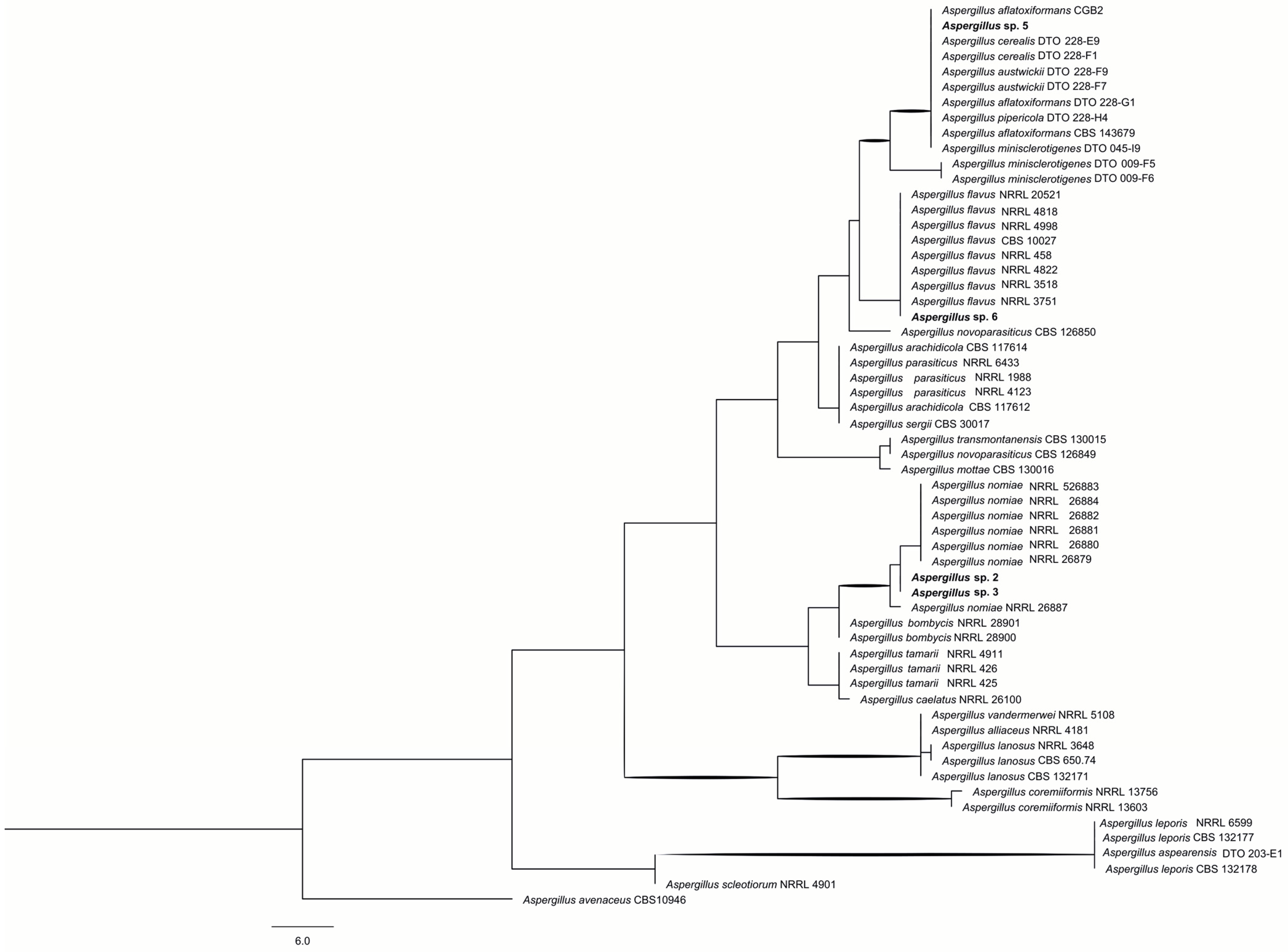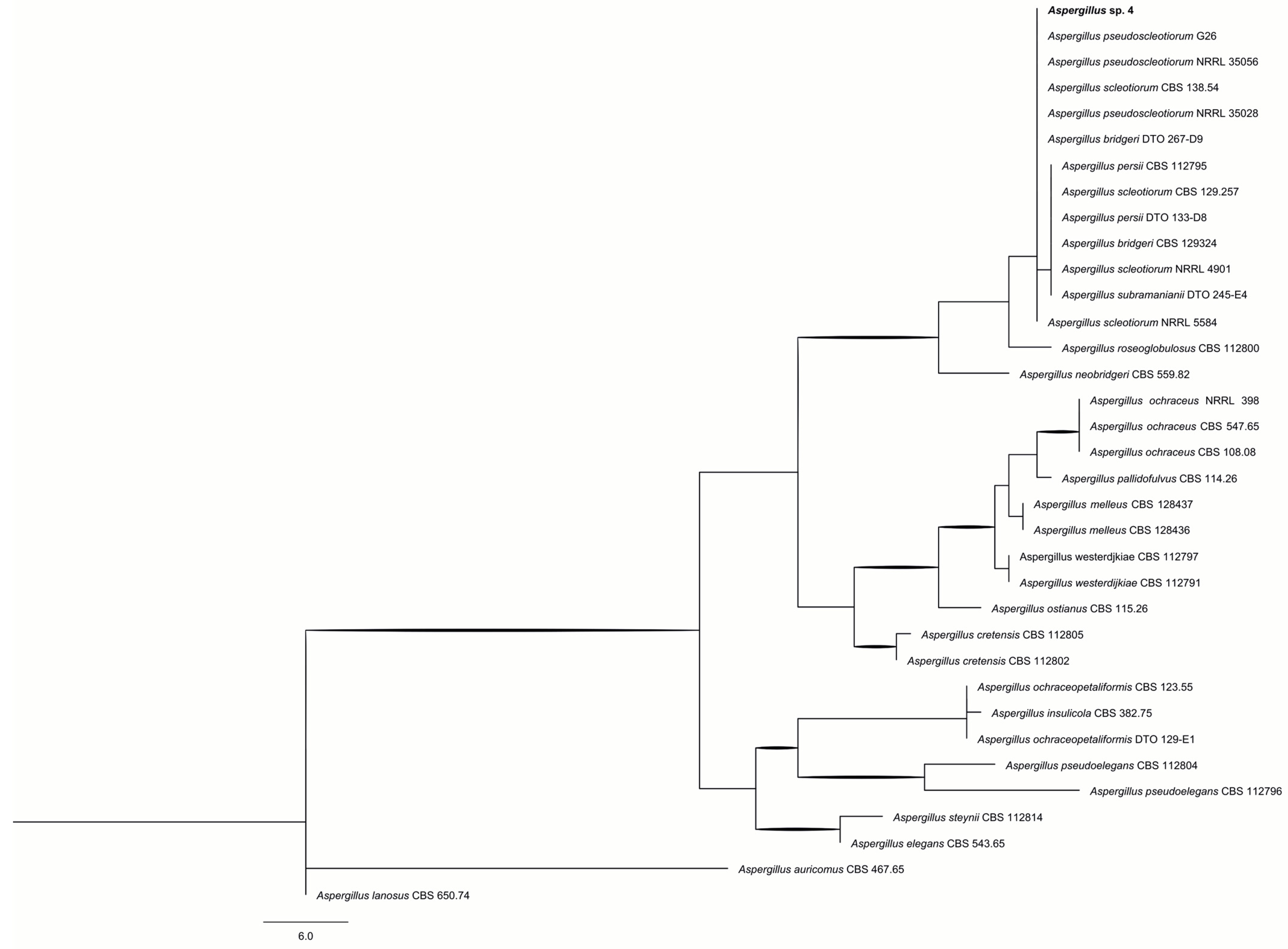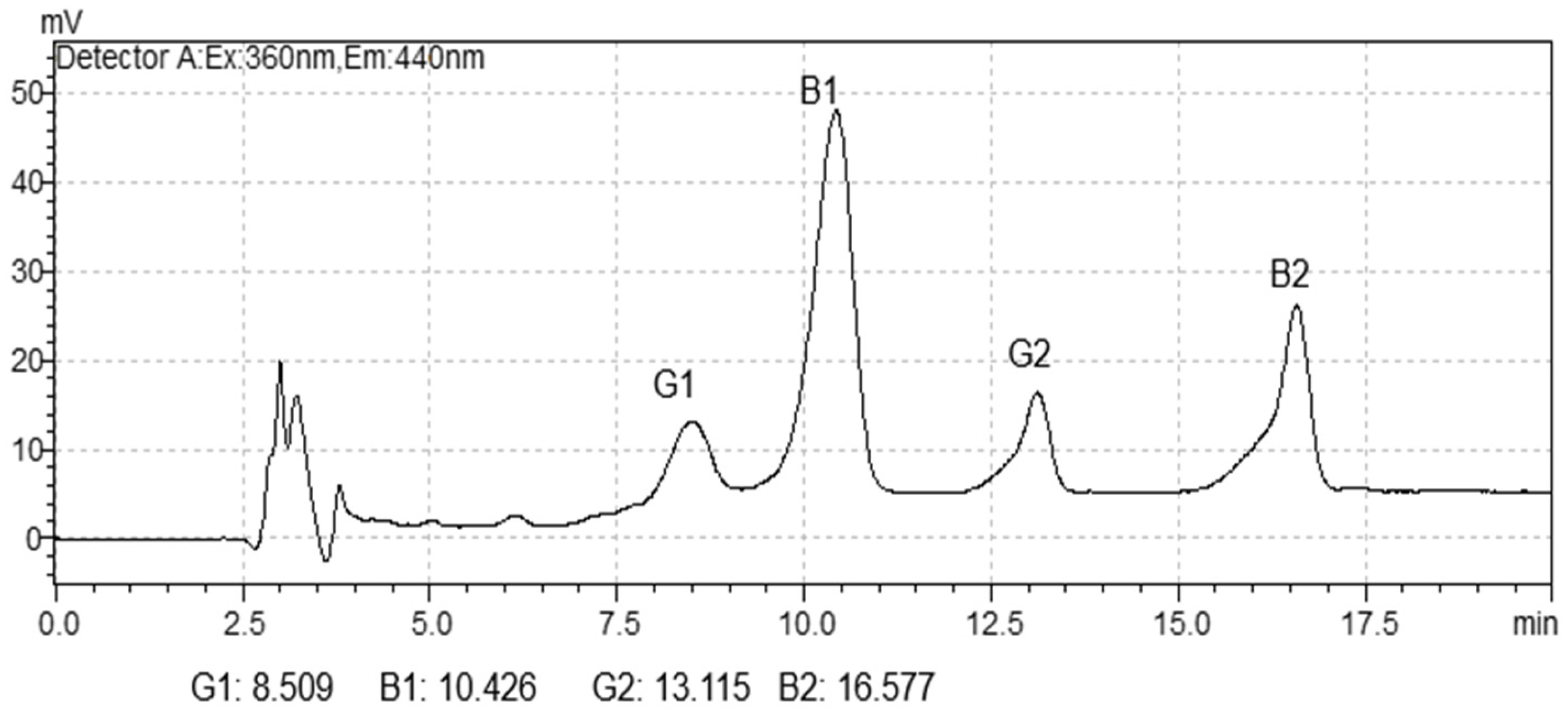Climate Change and Severe Drought Impact on Aflatoxins and Fungi in Brazil Nuts: A Molecular Approach
Abstract
1. Introduction
2. Results
2.1. Aflatoxins, Water Activity, and Moisture Content
2.2. Molecular Analysis
3. Discussion
4. Materials and Methods
4.1. Sampling
4.2. Moisture Content and Water Activity
4.3. Aflatoxin Quantification
4.4. Molecular Analysis
4.4.1. DNA Extraction, Polymerase Chain Reaction, and Sequencing Analysis of Housekeeping Gene ITS
4.4.2. Phylogenetic Analysis
5. Conclusions
Author Contributions
Funding
Institutional Review Board Statement
Informed Consent Statement
Data Availability Statement
Acknowledgments
Conflicts of Interest
References
- Kos, J.; Anić, M.; Radić, B.; Zadravec, M.; Janić Hajnal, E.; Pleadin, J. Climate Change-A Global Threat Resulting in Increasing Mycotoxin Occurrence. Foods 2023, 12, 2704. [Google Scholar] [CrossRef] [PubMed]
- Valencia-Quintana, R.; Mili, M.; Jaksii, D.; Tenorio-Arvide, M.G.; Klari, M.S.; Pérez-Flores, G.A.; Bonassi, S.; Sánchez-Alarcón, J. Environment Changes, Aflatoxins, and Health Issues, a Review. Int. J. Environ. Res. Public Health 2020, 17, 7850. [Google Scholar] [CrossRef] [PubMed]
- Loi, M.; Logrieco, A.F.; Pusztahelyi, T.; Leiter, E.; Hornok, L.; Pócsi, I. Advanced mycotoxin control and decontamination techniques in view of an increased aflatoxin risk in Europe due to climate change. Front. Microbiol. 2023, 13, 1085891. [Google Scholar] [CrossRef] [PubMed]
- Zingales, V.; Taroncher, M.; Martino, P.A.; Ruiz, M.J.; Caloni, F. Climate Change and Effects on Molds and Mycotoxins. Toxins 2022, 14, 445. [Google Scholar] [CrossRef] [PubMed]
- IARC—International Agency for Research on Cancer. Agents Classified by the IARC Monographs; IRAC: Lyon, France, 2016; pp. 1–116. [Google Scholar]
- da Silva, A.; Silveira, B.K.S.; de Freitas, B.V.M.; Hermsdorff, H.H.M.; Bressan, J. Effects of Regular Brazil Nut (Bertholletia excelsa H.B.K.) Consumption on Health: A Systematic Review of Clinical Trials. Foods 2022, 11, 2925. [Google Scholar] [CrossRef]
- Focker, M.; van Eupen, M.; Verweij, P.; Liu, C.; van Haren, C.; van der Fels-Klerx, H.J. Effects of Climate Change on Areas Suitable for Maize Cultivation and Aflatoxin Contamination in Europe. Toxins 2023, 15, 599. [Google Scholar] [CrossRef]
- Yu, J.; Hennessy, D.A.; Tack, J.; Wu, F. Climate change will increase aflatoxin presence in US Corn. Environ. Res. Lett. 2022, 17, 054017. [Google Scholar] [CrossRef]
- Sharma, R.K.; Kumar, S.; Vatta, K.; Bheemanahalli, R.; Dhillon, J.; Reddy, K.N. Impact of recent climate change on corn, rice, and wheat in southeastern (USA). Sci. Rep. 2022, 12, 16928. [Google Scholar] [CrossRef]
- Yunnes, N.B.S.; Oliveira, R.C.; Reis, T.; Baquião, A.C.; Rocha, L.O.; Correa, B. Effect of temperature on growth, gene expression, and aflatoxin production by Aspergillus nomius isolated from Brazil nuts. Mycotoxin Res. 2020, 36, 173–180. [Google Scholar] [CrossRef]
- Anjos, L.J.S.; Gonçalves, G.S.R.; Dutra, V.A.B.; Rosa, A.G.; Santos, L.B.; Barros, M.N.R. Brazil nut journey under future climate change in Amazon. PLoS ONE 2024, 19, e0312308. [Google Scholar] [CrossRef]
- Johnsson, P.; Lindblad, M.; Thim, A.M.; Jonsson, N.; Vargas, E.A.; Medeiros, N.L.; Brabet, C. Growth of aflatoxigenic moulds and aflatoxin formation in Brazil nuts. World Mycotoxin J. 2008, 1, 127–137. [Google Scholar] [CrossRef]
- Nji, Q.N.; Babalola, O.O.; Ekwomadu, T.I.; Nleya, N.; Mwanza, M. Six Main Contributing Factors to High Levels of Mycotoxin Contamination in African Foods. Toxins 2022, 14, 318. [Google Scholar] [CrossRef] [PubMed]
- Fountain, J.C.; Koh, J.; Yang, L.; Pandey, M.K.; Nayak, S.N.; Bajaj, P.; Zhuang, W.-J.; Chen, Z.-Y.; Kemerait, R.C.; Lee, R.D.; et al. Proteome analysis of Aspergillus flavus isolate-specific responses to oxidative stress in relationship to aflatoxin production capability. Sci. Rep. 2018, 8, 3430. [Google Scholar] [CrossRef] [PubMed]
- Nji, Q.N.; Babalola, O.O.; Mwanza, M. Aflatoxins in Maize: Can Their Occurrence Be Effectively Managed in Africa in the Face of Climate Change and Food Insecurity? Toxins 2022, 14, 574. [Google Scholar] [CrossRef] [PubMed]
- Akello, J.; Ortega-Beltran, A.; Katati, B.; Atehnkeng, J.; Augusto, J.; Mwila, C.M.; Mahuku, G.; Chikoye, D.; Bandyopadhyay, R. Prevalence of Aflatoxin- and Fumonisin-Producing Fungi Associated with Cereal Crops Grown in Zimbabwe, and Their Associated Risks in a Climate Change Scenario. Foods 2021, 10, 287. [Google Scholar] [CrossRef]
- Warnatzsch, E.A.; Reay, D.S.; Camardo Leggieri, M.; Battilani, P. Climate Change Impact on Aflatoxin Contamination Risk in Malawi’s Maize Crops. Front. Sustain. Food Syst. 2020, 4, 591792. [Google Scholar] [CrossRef]
- dos Santos, D.G.; Coelho, C.C.D.S.; Ferreira, A.B.R.; Freitas-Silva, O. Brazilian Coffee Production and the Future Microbiome and Mycotoxin Profile Considering the Climate Change Scenario. Microorganisms 2021, 9, 858. [Google Scholar] [CrossRef]
- Kluczkovski, A.M.; Silva, A.; Barroncas, J.; Lima, J.; Pereira, H.; Mariosa, P.; Vinhote, M.L. Drying in Brazil Nut Processing as Tool for Prevention of Contamination by Aflatoxins. J. Agric. Stud. 2020, 8, 70–81. [Google Scholar] [CrossRef]
- CAC—Codex Alimentarius Commission. Proposed Draft Maximum Level for Total Aflatoxins in Brazil Nuts; ALINORM 10/33/41 Appendix V, 47, Joint FAO/WHO Food Standards Program; FAO: Rome, Italy, 2010. [Google Scholar]
- ANVISA. Estabelece os Limites Máximos Tolerados (LMT) de Contaminantes em Alimentos; IN No. 160, 01/07/2022; Diário Oficial da União: Brasília, Brazil, 2022; No. 126. [Google Scholar]
- Frisvad, J.C.; Hubka, V.; Ezekiel, C.N. Taxonomy of Aspergillus section Flavi and their production of aflatoxins, ochratoxins and other mycotoxins. Stud. Mycol. 2019, 93, 1–63. [Google Scholar] [CrossRef]
- Leggieri, M.C.; Toscano, P.; Battilani, P. Predicted Aflatoxin B1 Increase in Europe Due to Climate Change: Actions and Reactions at Global Level. Toxins 2021, 13, 292. [Google Scholar] [CrossRef]
- Houbraken, J.; Frisvad, J.C.; Samson, R.A. Taxonomy of Penicillium section Citrina. Stud. Mycol. 2011, 70, 53–138. [Google Scholar] [CrossRef]
- Houbraken, J.; Kocsubé, S.; Visagie, C.M.; Yilmaz, N.; Wang, X.-C.; Meijer, M.; Kraak, B.; Hubka, V.; Bensch, K.; Samson, R.A.; et al. Classification of Aspergillus, Penicillium, Talaromyces and related genera (Eurotiales): An overview of families, genera, subgenera, sections, series, and species. Stud. Mycol. 2020, 95, 5–169. [Google Scholar] [CrossRef] [PubMed]
- Singh, U.; Shyam, G.; Meenakshi, G. A review study on biological ill effects and health hazards of aflatoxins. Asian J. Adv. Med. Sci. 2021, 3, 1–8. [Google Scholar]
- Baazeem, A.; Rodriguez, A.; Medina, A.; Magan, N. Impacts of Climate Change Interacting Abiotic Factors on Growth, aflD and aflR Gene Expression and Aflatoxin B1 Production by Aspergillus flavus Strains In Vitro and on Pistachio Nuts. Toxins 2021, 13, 385. [Google Scholar] [CrossRef] [PubMed]
- Vieira, D.O.; Souza, K.R.; Magalhães, L.A.; Véras, I.V.U.M.; Santos, S.C.L. The contamination of Brazil nut by aflatoxins and its carcinogenic effect: A narrative review. Res. Soc. Dev. 2022, 11, e52911730309. [Google Scholar] [CrossRef]
- Iamanaka, B.T.; Nakano, F.; Lemes, D.P.; Taniwaki, M. Aflatoxin evaluation in ready-to-eat Brazil nuts using reversed-phase liquid chromatography and post-column derivatization. Food Addit. Contam. Part A 2014, 31, 917–923. [Google Scholar] [CrossRef]
- Baquião, A.C.; Oliveira, M.M.M.; Reis, T.A.; Zorzete, P.; Atayde, D.D.; Corrêa, B. Monitoring and Determination of Fungi and Mycotoxins in Stored Brazil Nuts. J. Food Prot. 2013, 76, 1414–1420. [Google Scholar] [CrossRef]
- Pacheco, A.M.; Scussel, V.M. Selenium and Aflatoxin Levels in Raw Brazil Nuts from the Amazon Basin. J. Agric. Food Chem. 2007, 55, 11087–11092. [Google Scholar] [CrossRef]
- CE—Commission of the European Communities. COMMISSION REGULATION (EU) 2023/915 of 25 April 2023 on maximum levels for certain contaminants in food and repealing Regulation (EC) No 1881/2006. Off. J. Eur. Union 2023, L 119, 103–157. [Google Scholar]
- Osorio-Marín, N.J.; Fernandez, E.; Vieli, L.; Ribera, A.; Luedeling, E.; Cobo, N. Climate change impacts on temperate fruit and nut production: A systematic review. Front. Plant Sci. 2024, 15, 1352169. [Google Scholar] [CrossRef]
- Siqueira, J.P.Z.; Sutton, D.A.; Gené, J.; García, D.; Wiederhold, N.; Peterson, S.W.; Guarro, J. Multilocus Phylogeny and Antifungal Susceptibility of Aspergillus Section Circumdati from Clinical Samples and Description of A. pseudosclerotiorum sp. nov. J Clin. Microbiol. 2017, 55, 947–958. [Google Scholar] [CrossRef]
- Ibrahim, S.R.M.; Abdallah, H.M.; Mohamed, G.A.; Deshmukh, S.K. Exploring potential of Aspergillus sclerotiorum: Secondary metabolites and biotechnological relevance. Mycol. Prog. 2022, 22, 8. [Google Scholar] [CrossRef]
- INMET. Available online: https://portal.inmet.gov.br/boletinsagro (accessed on 15 May 2025).
- Espinoza, J.C.; Jimenez, J.C.; Marengo, J.A.; Schongart, J.; Ronchail, J.; Lavado-Casimiro, W.; Ribeiro, J.V.M. The new record of drought and warmth in the Amazon in 2023 related to regional and global climatic features. Sci. Rep. 2024, 14, 8107. [Google Scholar] [CrossRef]
- AOAC—Association of Official Analytical Chemists. Official Methods of Analysis, Method 931.04, 20th ed.; AOAC International: Gaithersburg, MD, USA, 2016. [Google Scholar]
- AOAC—Association of Official Analytical Chemists. Official Methods of Analysis, Method 994.08, 20th ed.; AOAC International: Gaithersburg, MD, USA, 2005. [Google Scholar]
- White, T.J.; Bruns, T.D.; Lee, S.B.; Taylor, J.W. Amplification and direct sequencing of fungal ribosomal RNA genes for phylogenetics. In PCR Protocols: A Guide to Methods and Applications; Innis, M.A., Gelfand, D.H., Sninsky, J.J., White, T.J., Eds.; Academic Press: New York, NY, USA, 1990; Volume 18, pp. 315–322. [Google Scholar]
- Glass, N.L.; Donaldson, G.C. Development of primer sets designed for use with the PCR to amplify conserved genes from filamentous ascomycetes. Appl. Environ. Microbiol. 1995, 61, 1323–1330. [Google Scholar] [CrossRef]
- Swofford, D.L.P. Phylogenetic Analysis Using Parsimony (*and Other Methods); Sinauer Associates: Sunderland, MA, USA, 2002. [Google Scholar]
- Rambaut, A.; Drummond, A. FigTree v1. 3.1; Institute of Evolutionary Biology, University of Edinburgh: Edinburgh, UK, 2010. [Google Scholar]




| Harvest | Aflatoxins µg/kg Mean ± SD (Range) | Samples >Legal Limit * | Positive AFL Samples | ||||
|---|---|---|---|---|---|---|---|
| B1 | B2 | G1 | G2 | Total | |||
| 2023 | 3.22 ± 3.3 (0.39–9.16) | 0.96 ± 1.7 (Nd–4.45) | 3.28 ± 1.82 (1.55–6.59) | 1.07 ± 0.16 (0.94–1.09) | 8.54 ± 5.4 (3.19–16.53) | 10% | 100% |
| Water Activity | Moisture Content (%) | |||||
|---|---|---|---|---|---|---|
| Mean ± SD | Range | >0.7 * | Mean ± SD | Range | >15 ** | |
| 2023 | 0.77 ± 0.65 | 0.60–0.93 | 90% | 4.77 ± 1.5 | 2.6–7.7 | 0% |
Disclaimer/Publisher’s Note: The statements, opinions and data contained in all publications are solely those of the individual author(s) and contributor(s) and not of MDPI and/or the editor(s). MDPI and/or the editor(s) disclaim responsibility for any injury to people or property resulting from any ideas, methods, instructions or products referred to in the content. |
© 2025 by the authors. Licensee MDPI, Basel, Switzerland. This article is an open access article distributed under the terms and conditions of the Creative Commons Attribution (CC BY) license (https://creativecommons.org/licenses/by/4.0/).
Share and Cite
Kluczkovski, A.M.; Barroncas, J.S.; Lemos, H.; Barros, H.L.; Sodré, L.; Rocha, L.d.O.; Soto, T.S.; Vinhote, M.L.; Kluczkovski, A., Jr. Climate Change and Severe Drought Impact on Aflatoxins and Fungi in Brazil Nuts: A Molecular Approach. Int. J. Mol. Sci. 2025, 26, 9592. https://doi.org/10.3390/ijms26199592
Kluczkovski AM, Barroncas JS, Lemos H, Barros HL, Sodré L, Rocha LdO, Soto TS, Vinhote ML, Kluczkovski A Jr. Climate Change and Severe Drought Impact on Aflatoxins and Fungi in Brazil Nuts: A Molecular Approach. International Journal of Molecular Sciences. 2025; 26(19):9592. https://doi.org/10.3390/ijms26199592
Chicago/Turabian StyleKluczkovski, Ariane Mendonça, Janaína Santos Barroncas, Hanna Lemos, Heloisa Lira Barros, Leiliane Sodré, Liliana de Oliveira Rocha, Taynara Souza Soto, Maria Luana Vinhote, and Augusto Kluczkovski, Jr. 2025. "Climate Change and Severe Drought Impact on Aflatoxins and Fungi in Brazil Nuts: A Molecular Approach" International Journal of Molecular Sciences 26, no. 19: 9592. https://doi.org/10.3390/ijms26199592
APA StyleKluczkovski, A. M., Barroncas, J. S., Lemos, H., Barros, H. L., Sodré, L., Rocha, L. d. O., Soto, T. S., Vinhote, M. L., & Kluczkovski, A., Jr. (2025). Climate Change and Severe Drought Impact on Aflatoxins and Fungi in Brazil Nuts: A Molecular Approach. International Journal of Molecular Sciences, 26(19), 9592. https://doi.org/10.3390/ijms26199592








